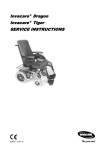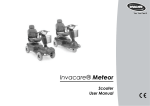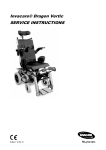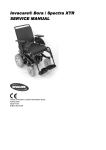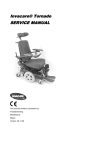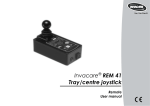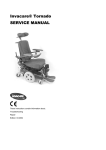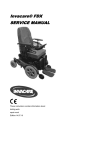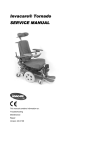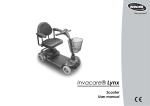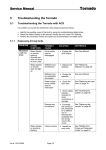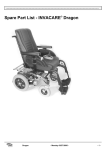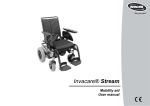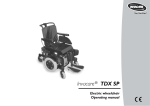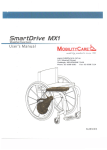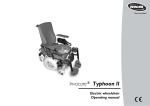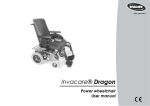Download Invacare® Dragon Invacare® Tiger SERVICE INSTRUCTIONS
Transcript
Invacare® Dragon Invacare® Tiger SERVICE INSTRUCTIONS These instructions contain information on: Inspection work Repair work Issue: 21/04/10 : +43 6232 55 35 0 Herzog Odilostrasse 101 Fax: +43 6232 55 35 4 A-5310 Mondsee @: Austria @: Mobitec Mobilitätshilfen GmbH [email protected] [email protected] WWW: www.mobitec-austria.com : +32 (0)50 83 10 10 Autobaan 22 Fax: +32 (0)50 83 10 11 B-8210 Loppem (Brugge) @: Belgium WWW: Invacare® n.v. [email protected] www.invacare.be : +41 (0)61 48 77 08 0 Benkenstraße 260 Fax: +41 (0)61 48 77 08 1 CH-4108 Witterswil @: [email protected] Switzerland @: [email protected] Mobitec Rehab AG WWW: www.mobitec-rehab.ch +49 (0)75 62 7 00 0 Invacare Aquatec Alemannenstraße 10 Fax 88316 Isny @: Deutschland WWW: +49 (0)75 62 7 00 66 [email protected] www.invacare-aquatec.de (Kundeservice): Invacare® A/S Sdr. Ringvej 37 Fax (Kundeservice): DK-2605 Brøndby @: Danmark WWW: +45 (0)36 90 00 00 +45 (0)36 90 00 01 [email protected] www.invacare.dk : +34 (0)972 49 32 00 c/ Areny, s/n Fax: +34 (0)972 49 32 20 Polígon Industrial de Celrà @: E-17460 Celrà (Girona) WWW: Invacare® SA [email protected] www.invacare.es ESPAÑA : +33 (0)247 62 64 66 Route de St Roch Fax: +33 (0)247 42 12 24 F-37230 Fondettes @: France WWW: Invacare® Poirier SAS (Customer Service): Invacare® Ltd 2 [email protected] www.invacare.fr +44 (0)1656 776 222 Pencoed Technology Park Fax (Customer Service): Pencoed @: +44 (0)1656 776 220 [email protected] Bridgend CF35 5HZ @: [email protected] United Kingdom WWW: www.invacare.co.uk : +39 0445 38 00 59 Via Dei Pini, 62 Fax: +39 0445 38 00 34 I - 36016 Thiene (VI) @: ITALIA WWW: Invacare Mecc San s.r.l. [email protected] www.invacare.it : +353 18 10 70 84 Unit 5 Seatown Business Campus Fax: +353 18 10 70 85 Seatown Rd, Swords @: County Dublin WWW: Invacare Ireland Ltd. [email protected] www.invacare.ie Ireland (Kundeservice): Invacare® AS Grensesvingen 9 Fax (Kundeservice): Postboks 6230 @: Etterstad WWW: +47 (0)22 57 95 00 +47 (0)22 57 95 01 [email protected] www.invacare.no N-0603 Oslo Norge Invacare® B.V. : +31 (0)318 69 57 57 Celsiusstraat 46 Fax: +31 (0)318 69 57 58 NL-6716 BZ Ede @: Nederland WWW: Invacare Portugal, Lda [email protected] www.invacare.nl : +351 225 1059 46 : +351 225 1059 47 Rua Estrada Velha, 949 P-4465-784 Leça do Balio Fax: Portugal @: WWW: +351 225 1057 39 [email protected] www.invacare.pt 3 (Kundtjänst): Återförsäljare: +46 (0)8 761 70 90 Invacare® AB Fax (Kundtjänst): +46 (0)8 761 81 08 Fagerstagatan 9 @: [email protected] S-163 91 Spånga @: [email protected] Sverige WWW: Tillverkare: MÖLNDAL www.invacare.se : +46 (0)31 86 36 00 Kleiststraße 49 Fax: +46 (0)31 86 36 06 D-32457 Porta Westfalica @: Invacare® Deutschland GmbH [email protected] Deutschland LANDSKRONA : +46 (0)418 285 40 Fax: +46 (0)418 180 89 @: [email protected] OSKARSHAMN : Fax: @: 4 +46 (0)491 101 40 +46 (0)491 101 80 [email protected] Table of Contents Chapter Page TABLE OF CONTENTS 5 1 7 INTRODUCTION 1.1 General information 7 1.2 Notes on transport 7 1.3 Definition and representation of information and safety information in this manual 8 1.4 Hazard symbols and symbols used 9 1.5 Images in this manual 2 SAFETY AND FITTING INSTRUCTIONS 10 11 2.1 Before any inspection or repair work 11 2.2 Personal safety equipment 11 2.3 General safety information and information about fitting / removal 11 3 TIGHTENING TORQUES 13 4 ARRANGEMENT OF THE ASSEMBLY GROUPS AND COMPONENTS 14 5 SERVICE PLAN (1X ANNUALLY) 15 6 OPERATIONAL FAULTS 17 6.1 6.1.1 6.1.2 Operational faults on a wheelchair fitted with Shark electronics Diagnosis of actuation disorders Shark error codes and diagnostic codes 17 17 19 6.2 6.2.1 6.2.2 6.2.3 Troubleshooting the Tornado with ACS Diagnosing driving faults Diagnosing problems with electric actuators REM24 Error Codes and Diagnostic Codes 21 21 23 24 7 REPAIR WORK 26 7.1 General warning information on installation work 26 7.2 Replacing the motor 26 5 7.3 Replacing the Shark Electronics 31 7.4 Updating the driving program 33 7.5 7.5.1 7.5.2 Changing the batteries Removing the batteries How to handle damaged batteries correctly 34 35 36 7.6 Checking and replacing the main fuse 37 7.7 Checking the cables 39 7.8 Replacing the Shark Remote 41 7.9 Replacing the ACS Remote 43 7.10 Replacing the steering head bearings on the steering wheels 45 7.11 Repairing a flat tyre 7.11.1 Repairing the flat tyre (pneumatic tyre equipment type 12½ x 2¼") 7.11.2 Repairing a flat tyre (pneumatic tyre equipment type 220/120 x 50) 47 47 48 7.12 50 Replacing a drive wheel 7.13 Adjusting the seat angle/seat height 7.13.1 Adjustment tables 51 53 7.14 Replacing the safety belt 56 7.15 Testing an actuator motor 56 6 1 Introduction 1.1 General information 1.2 • Service and maintenance work must be carried out taking this service manual into account. • It is imperative that you observe safety information. • Information about operation or about general maintenance and care work on the mobility aid should be taken from the operating manual. • You can find information about ordering spare parts in the spare parts catalogue. • Only use original Invacare® spare parts. The guarantee will become invalid if other spare parts are used! • We reserve the right to make any alterations on the grounds of technical improvements. • The mobility aid may only be maintained and overhauled by qualified personnel. • The minimum requirement for service technicians is suitable training, such as in the cycle or orthopaedic mechanics fields, or sufficiently long-term job experience. - Experience in the use of electrical measuring equipment (multimeters) is also a requirement. - Special Invacare® training is recommended. • Alterations to the mobility aid which occur as a result of incorrectly or improperly executed maintenance or overhaul work lead to the exclusion of all liability on the side of INVACARE. • If you have any problems or questions please contact Invacare® Service. Notes on transport • If the mobility aid has to be shipped back to the manufacturer for major repairs, you should always use the original packaging for transport. • Please attach a precise description of the fault. 7 1.3 Definition and representation of information and safety information in this manual Different types of information and signal words are used throughout this manual. HAZARD! The signal word "HAZARD!" refers to immediate hazards. • The following lines in italics refer to actions which serve to avoid such hazards. WARNING! The signal word "WARNING!" refers to possibly-occurring hazards which can lead to death or serious injuries if they are not avoided. • The following lines in italics refer to actions which serve to avoid such hazards. ATTENTION! The signal word "ATTENTION!" refers to possibly-occurring hazards which can lead to minor injuries and/or material damage if they are not avoided. • The following lines in italics refer to actions which serve to avoid such hazards. CAUTION! The signal word "CAUTION!" refers to hazards which could lead to material damage if they are not avoided. • The following lines in italics refer to actions which serve to avoid such hazards. Note The signal word "Note" is used to denote general information which simplifies the handling of your product and refers to special functions. 8 1.4 Hazard symbols and symbols used Different types of hazard symbols and symbols are used throughout this manual. General hazards This symbol warns you of general hazards! • Always follow the instructions to avoid injury to the user or damage to the product! BURN HAZARD! This symbol warns you of the danger of chemical burns, for example due to the discharge of battery acids! • Always follow the instructions to avoid injury to the user or damage to the product! DANGER OF CRUSHING! This symbol warns you of crushing hazards due to inattentive working with heavy components. • Always follow the instructions to avoid injury to the user or damage to the product! EXPLOSION HAZARD! This symbol warns you of an explosion hazard, which can be caused by excessive tyre pressure in a pneumatic tyre. • Always follow the instructions to avoid injury to the user or damage to the product! Wear safety shoes The symbol refers to the requirement for wearing safety shoes. • Wear standardised safety shoes during all work. Wear eye protection This symbol refers to the requirement for wearing eye protection, for example when working with batteries. • Wear eye protection when this symbol is shown. Wear safety gloves This symbol refers to the requirement for wearing safety gloves, for example when working with batteries. • Wear safety gloves when this symbol is shown. Note This symbol identifies general information which is intended to simplify working with your product and which refers to special functions. Requirements: • This symbol identifies a list of various tools, components and items which you will need in order to carry out certain work. Please do not attempt to carry out the work if you do not have the listed tools available. Always dispose used or damaged batteries correctly The symbol refers to information for the correct disposal of used or damaged batteries. 9 1.5 Images in this manual The detailed images in this manual are given digits to identify various components. Component numbers in text and operational instructions always relate to the image directly above. 10 2 Safety and fitting instructions These safety instructions are intended to prevent accidents at work, and it is imperative that they are observed. 2.1 2.2 Before any inspection or repair work • Read and observe this repair manual and the associated operating manual! • Observe the minimum requirements for carrying out the work (see chapter entitled „General information)! Personal safety equipment Safety shoes The mobility device, and some of its components, are very heavy. These parts can result in injuries to the feet if they are allowed to drop. • Wear standardised safety shoes during all work. Eye protection It is possible that battery acid can be discharged when working on defective batteries or when handling batteries improperly. • Always wear eye protection when working on any defective or possibly defective batteries. Safety gloves It is possible that battery acid can be discharged when working on defective batteries or when handling batteries improperly. • Always wear acid-proof safety gloves when working on any defective or possibly defective batteries. 2.3 General safety information and information about fitting / removal WARNING: Danger of crushing! Various components such as the drive unit, batteries, seat etc are very heavy. This results in injury hazards to your hands! • Please note the high weight of some components! This applies especially to the removal of drive units, batteries and the seat. WARNING! Injury hazard if the vehicle starts moving unintentionally during repair work! • Switch the power supply off (ON/OFF key)! • Engage the drive! • Before raising the vehicle, secure the wheels by blocking them with wedges! ATTENTION! Fire and burn hazard due to electrical short-circuit! • The mobility device must be completely switched off before removal of voltage-carrying components! To do this, remove the batteries. • Avoid short-circuiting the contacts when carrying out measurements on voltage-carrying components! 11 ATTENTION! Injury hazard and danger of damage to vehicle due to improper or incomplete maintenance work! • Use only undamaged tools in good condition. • Some moving parts are mounted in sockets with PTFE coating (Teflon™). Never grease these sockets! • Never use "normal" nuts instead of self-locking nuts. • Always use correctly-dimensioned washers and spacers • When reassembling, always replace any cable ties which were cut during dismantling. • After completing your work / before renewed start-up of the mobility device, check all connections for tight fitting. • After completing your work / before renewed start-up of the mobility device, check all parts for correct locking. • Only operate the vehicle with the approved tyre pressures (see technical data). • Check all electrical components for correct function. Please note that incorrect polarity can result in damage to the electronics. • Always carry out a trial run at the end of your work. Note Mark all current settings for the mobility aid (seat, armrests, backrest etc.), and the associated cable connecting plugs, before dismantling. This makes reassembly easier. All plugs are fitted with mechanical safety devices which prevent release of the connecting plugs during operation. To release the connecting plugs the safety devices must be pressed in. When reassembling ensure that these safety devices are correctly engaged. WARNING! Any changes to the drive program can affect the driving characteristics and the tipping stability of the vehicle! • Changes to the drive program may only be carried out by trained Invacare® specialist dealers! • Invacare® supplies all mobility aids with a standard drive program ex-works. Invacare® can only give a warranty for safe vehicle driving behaviour - especially tipping stability - for this standard drive program! 12 3 Tightening torques The tightening torques stated in the following list are based on the thread diameter for the nuts and bolts for which no specific values have been determined. All values assume dry and de-greased threads. Thread M4 M5 M6 M8 M10 M12 Tightening torque in Nm ±10% 3 Nm 6 Nm 10 Nm 25 Nm 49 Nm 80 Nm M14 M16 120 Nm 180 Nm CAUTION! Damage can be caused to the mobility device due to improperly tightened screws, nuts or plastic connections. • Always tighten screws, nuts etc to the stated tightening torque. • Only tighten screws or nuts which are not listed here fingertight. 13 4 Arrangement of the assembly groups and components Under the seat: 1) Decoupling mechanism 2) Power module 3) Perforated plates for adjusting the seat height and seat angle Under the battery cover 4) Main battery fuse 14 5 Service plan (1x annually) Component Armrests and side panels Seat unit / seat angle adjustment Backrest unit mechanical Backrest unit electrical (if installed) Check Action • Armrest damage and fastening • Side panel damage and fixing • Cushion • Check seat angle adjustment • Tighten screws, replace padding if damaged • Tighten screws, replace side panels if damaged • Replace covers / upholstery if damaged • Replace parts if damaged • Replace parts if damaged • Tighten screws • Replace cable or motor if necessary • Damage and seams • Fixing • Check cabling • Check function • Check fixings, • Tighten screws, replace welded seams and components battery box • Check drive • Adjust, replace wheel Wheel wheels for tight fit hubs suspension and and side play wheels Notes Frame (chassis) / battery box • Check steering • Replace wheels, wheel wheels for tight fit, fork or wheel bearings float, side play and correct torque (15 Nm +/- 1.5 Nm) See "Replacing the steering head bearings on the steering wheels" on page 45 • Pneumatic tyres (if • Repair or replace if available) damaged See "Repairing a flat tyre" on page 47 Electrical footrests (if installed) • Check functions in • Replace motor if drive and push necessary modes • Tighten screws / nuts, • Check disengager adjust or replace if necessary • Check welded • Tighten, replace if seams, necessary interlocking, screws, footplates • Replace cable if • Check cabling necessary • Check contacts • Check functions Lighting (if installed) • Check cabling • Check function • Replace bulbs or cables if necessary • Check batteries for damage • Replace batteries if necessary Drive units, disengager Legrests Batteries See "Replacing a drive wheel" on page 50 See "Changing the batteries" on page 34 15 Component Remote / electronics Driving Programme 16 Check Action Notes • Check battery charge • Check contacts and terminals for corrosion • Charge batteries See User Manual • Clean contacts and terminals See "Changing the batteries" on page 34 for safety information when handling batteries • Remote, status display blinking • Fixing • Cable, connecting plug • Joystick function • Power supply • Check the programme version of the driving electronics. Is there a newer version available? • • • • • Evaluate flash code Tighten, replace Replace Replace joystick Replace cable, connector plug or console • Update the software. See "Updating the driving program" on page 33 6 Operational Faults 6.1 Operational faults on a wheelchair fitted with Shark electronics Please proceed as follows in the event of operational faults: • First of all analyse the possible cause of the disorder on the basis of the following tables. • Check the status display on the remote. Analyse the flashing error code. • Carry out the necessary checks and repairs as recommended in the following table. 6.1.1 Diagnosis of actuation disorders • SOLUTION DOCUMENTATION Actuation motors may be disengaged • Clutch in actuation motors See operating instructions Batteries may be faulty • Replace the batteries See "Changing the batteries" on page 34 Batteries may be almost empty • Charge batteries See User Manual Power supply to the remote may be interrupted • Check the main fuse See "Checking and replacing the main fuse" on page 37 • Check the cable between the modules for any loose connections or damage • Change the remote on the wheelchair to be able to exclude the remote being the cause of the fault. • Analyse error code Siehe "Checking the cables" on page 39 PROBLEM OTHER SYMPTOMS POSSIBLE CAUSE Wheelchair will not start up Status display on the remote illuminated as normal and does not indicate a disorder code Status display on the remote is not illuminated Remote may be faulty Status display on remote flashing Various causes See "Replacing the Shark Remote" on page 41 See "Shark error codes and diagnostic codes" on page 19 17 PROBLEM Wheelchair jerky in drive operation Batteries not being charged Wheelchair drives too slowly 18 OTHER SYMPTOMS None POSSIBLE CAUSE • SOLUTION DOCUMENTATION Batteries may be faulty (instable voltage) • Replace the batteries See "Changing the batteries" on page 34 Actuation motor(s) may be faulty • Replace motor(s) Siehe "Replacing the motor" on page 26 None Batteries may be faulty • Replace batteries See "Changing the batteries" on page 34 LEDs flashing on charger Charger may be faulty • Replace charger See operating instructions for battery charger None Batteries may be faulty • Replace batteries See "Changing the batteries" on page 34 6.1.2 Shark error codes and diagnostic codes The actuation electronics can automatically remedy certain disorders. In this case the status display will stop flashing. Please switch the remote on and off several times. Please wait about 5 seconds every time before switching the remote on again. If the error is not remedied by this, please diagnose the cause on the basis on the following flashing codes. FLASHING CODE Meaning Solution FLASHING CODE 1 Operational error • Please ensure that the joystick is in neutral central position (simply release joystick) and switch on again. 2 Battery error • Check battery and power cable. See "Checking the cables" on page 39 • Charge batteries. If you switch the wheelchair off for a few minutes the batteries are often able to re-charge sufficiently to enable a short journey. You should, however, only use this solution in an emergency as this leads to the batteries discharging excessively. See operating instructions • Replace the batteries See "Changing the batteries" on page 34 • Check the motor cable and Uconnector. • Check the motor. See "Checking the cables" on page 39 • Check the motor cable and Uconnector. • Check the motor. 3 4 Error on the left motor (M2) Error on the right motor (M1) See "Replacing the motor" on page 26 See "Checking the cables" on page 39 See "Replacing the motor" on page 26 5 Fault on the left (M2) motor brake • Check cable and connector. See "Checking the cables" on page 39 6 Fault on the right (M1) motor brake • Check cable and connector. See "Checking the cables" on page 39 7 Fault on the Shark remote • Check the bus cable on the remote and U-connector. • Replace the remote. See "Checking the cables" on page 39 See "Replacing the Shark Remote" on page 41 19 FLASHING CODE 8 9 Meaning Fault on Shark main module Communication error on the Shark system Solution • Check all cables and connectors on the Shark system. • Replace the main module. • Check all cables and connectors on the Shark system. • Replace the remote. FLASHING CODE See "Checking the cables" on page 39 See "Replacing the Shark Electronics" on page 31 See "Checking the cables" on page 39 See "Replacing the Shark Remote" on page 41 10 Unknown error • Check all cables and U-connectors. See "Checking the cables" on page 39 11 Incompatible remote • An incorrect remote has been connected. Ensure that main module and remote code are concordant. See "Replacing the Shark Remote" on page 41 See "Replacing the Shark Electronics" on page 31 20 6.2 Troubleshooting the Tornado with ACS If a problem occurs with the wheelchair, then please proceed as follows: • Identify the possible cause of the fault by using the troubleshooting tables below. • Check the Status Display on the remote. Identify the error code if it is flashing. • Perform the necessary checks and repairs as recommended in the table below. 6.2.1 Diagnosing driving faults PROBLEM OTHER SYMPTOMS POSSIBLE CAUSE SOLUTION REFERENCE Wheelchai r will not drive Status display on remote lights up normally and does not show an error code Drive motors may be disengaged • Engage the drive motors See User Manual Status display on remote does not light up Batteries may be defective • Replace the batteries See "Changing the batteries" on page 34 Batteries may be completely discharged • Charge the batteries See User Manual Power supply to the remote may be interrupted • Check the main fuse See "Checking and replacing the main fuse" on page 37 • Check cables between modules for loose connections or damage See "Checking the cables" on page 39 Remote may be defective • Exchange the remote on the wheelchair for a different one to eliminate the possibility that the remote may be the cause. See "Replacing the Shark Remote" on page 41 Various causes • Identify the error code See "REM24 Error Codes and Diagnostic Codes" on page 24 Status display on remote is flashing 21 PROBLEM Wheelchai r does not drive smoothly Batteries cannot be charged Wheelchai r drives too slowly 22 OTHER SYMPTOMS None POSSIBLE CAUSE SOLUTION REFERENCE Batteries may be defective (voltage not stable) • Replace the batteries See "Changing the batteries" on page 34 Drive motor(s) may be defective • Replace the drive motor(s) See "Replacing the motor" on page 26 None Batteries may be defective • Replace the batteries See "Changing the batteries" on page 34 LEDs on the charger are flashing Charger may be defective • Replace the charger See User Manual of the charger None Remote may be defective • Replace the remote See "Replacing the Shark Remote" on page 41 Batteries may be defective • Replace the batteries See "Changing the batteries" on page 34 6.2.2 Diagnosing problems with electric actuators In case an electric actuator will not function, identify the source of the problem using the following table: PROBLEM OTHER SYMPTOMS POSSIBLE CAUSE SOLUTION REFERENCE Electric Actuator does not function Remote displays a flashing "E", status diode on the CLAM does not go out, even if the remote is switched off or disconnected CLAM is defective • Replace the CLAM See "Replacing the Shark Electronics" on page 31 None Cable may be disconnected or damaged • Check that the cable is not disconnected or damaged. If necessary, replace the cable See "Checking the cables" on page 39 Electric actuator may be defective • Test the actuator See "Testing an actuator motor" on page 56 Remote may be defective • Exchange the remote on the wheelchair for a different one to eliminate the possibility that the remote may be the cause. See "Replacing the Shark Remote" on page 41 23 6.2.3 REM24 Error Codes and Diagnostic Codes The drive electronics are capable of rectifying some errors automatically. In this case the status display will cease to flash. Please switch the remote on and off several times. Wait approx. 5 seconds each time before switching the remote on again. If this does not rectify the error, locate the error using the flash codes shown below. FLASHCODE MEANING SOLUTION DOCUMENTATION 1 Module defective • Replace defective module See "Replacing the Shark Electronics" on page 31 2 Accessory error (e.g. actuator short-circuit) • See "Testing an Check accessory connections, check actuator motor" on page 56 accessories 3 Fault in left-hand motor. Connection loose/defective or motor defective. • Check plug-in connections. See "Checking the cables" on page 39 • Replace motor See "Replacing the motor" on page 26 Fault in right-hand motor. • Connection loose/defective or motor • defective. Check plug-in connections. See "Checking the cables" on page 39 Replace motor See "Replacing the motor" on page 26 Fault/brake fault on lefthand motor. Connection loose/defective or motor defective. • Check plug-in connections. See "Checking the cables" on page 39 • Replace motor See "Replacing the motor" on page 26 Fault/brake fault on righthand motor. Connection loose/defective or motor defective. • Check plug-in connections. See "Checking the cables" on page 39 • Replace motor See "Replacing the motor" on page 26 7 Battery dead • Pre-charge battery See User Manual 8 Battery voltage too high • Switch lights on to lower battery voltage See User Manual of the charger • Check battery charger • - 4 5 6 9 or 10 Faulty data transmission between modules Remove all electronic modules except the Power Module and the Remote. Re-attach modules one by one to determine which one is causing the fault. See "Replacing the Shark Electronics" on page 31 24 FLASHCODE MEANING SOLUTION DOCUMENTATION 11 Motors overloaded / overheated • Switch remote on and off / wait if necessary - 12 Module used has compatibility problems • Remove incorrect module See "Replacing the Shark Electronics" on page 31 25 7 Repair Work 7.1 General warning information on installation work CAUTION:! Danger of damage to vehicle! Collisions can be caused if the adjusting washers are removed during fitting work to the drive wheels! Adjusting washers are often fitted between the drive shaft and the wheel hub to even out tolerances. If these adjusting washers are removed and not replaced again, collisions can be caused! • Always replace the adjusting washers exactly as they were before you started dismantling! 7.2 Replacing the motor WARNING: Danger of crushing! The mobility and the seat are very heavy. Danger of injury hazard to hands and feet caused by uncontrolled tilting oder other movement! • You should seek help from a second person! • Remove the seat and place the mobility device upside down so that the wheels are facing upwards! This guarantees mobility device stability during repair work! • Please see the following work steps for further important information. • Use a wooden chock underneath the battery box that is large enough to provide the wheelchair with large-area support, when jacking up the wheelchair! This improves the tipping stability of the wheelchair during repair work. ATTENTION: Fire and burns hazard if battery terminal is bypassed! • Please take great care to ensure that the battery terminals are never short-circuited with tools or mechanical mobility device parts! • Ensure that the battery terminal caps have been replaced if you are not working on the battery terminals. Pre-requisites: • Small, flat screwdriver • 5 mm Allen key • 8 mm Allen key • 11 mm open-ended spanner • 19 mm open-ended spanner • Aglet, diameter 2.5 mm (for knocking the splint out of the decoupling leverage) • Small hammer • Edge cutter • Cable binder • Wooden chock (approx. 12 x 12 x 30 cm) for jacking up the vehicle Information Please take care of the small parts and observe the sequence in which the component parts are installed. Please set them out in an orderly fashion so that they can be installed again easily in the correct sequence. 26 • Jack up the vehicle using the wooden chock. • Loosen the socket head screw (1) using a 5 mm Allen key. • Remove the screw and the hub cap. • Pull the complete wheel from the wheel hub. • Remove the battery cover. • Pull off the battery pole caps and push back to gain access to the battery poles. • Loosen the battery pole clips with the 11 mm open-ended spanner. • Remove the batteries. 27 28 • In order to remove the motor, the front decoupling rod connection (1) must be disconnected. Release the retaining ring (1) using the small, flat screwdriver and pull out. • Disengage the decoupling leverage from the motor. • Unscrew handwheels (screws) (1) on both sides of the panelling for the electronics. • Remove the panelling for the electronics. • Pull the motor plug on the motor to be replaced out of the electronics. • The motor cable is secured to the frame with a cable binder. Use the edge cutter to cut through the cable binder. • Loosen the motor suspension (1) using the 8 mm Allen key and the 19 mm open-ended spanner and remove. • Remove the motor from the suspension in a downward direction. • Loosen the four screws (1) on the motor suspension and remove. • Use the aglet and the hammer to carefully knock the splint (2) out of the decoupling leverage (1). • Remove the decoupling leverage (1) together with the decoupling rod (cannot be seen in the picture on the right) from the old motor. CAUTION! Damage to the motor is possible! • Only apply moderate pressure to the decoupling lever when fitting to the metal rod on the new motor. • Do not use a hammer! Information The simplest way to install the decoupling lever is to do this before the motor and other parts are assembled together. 29 30 • Carefully press the decoupling leverage (1) onto the rod (2) protruding from the new motor. • Press the splint (3) in. • The motor is installed in the reverse order. • Secure the motor cable by means of a new cable binder. 7.3 Replacing the Shark Electronics Pre-requisites: • Phillips screwdriver • To modify a drive programme you will need: Programming software or a Handheld Programmer and the Installation Manual of the Shark Electronics (Part Number 1436160), available from Invacare®. NOTE All electronic modules are supplied with a standard drive programme. If the driving programme has been customised, then you will have to perform this customisation again, after installing the new electronic module. WARNING! Every alteration to the drive programme can influence vehicle handling and the tipping stability of the wheelchair! • Alterations to the drive programme must only be carried out by trained Invacare®-dealers! • Invacare® can only assume a warranty for the safe vehicle handling of the wheelchair – in particular tipping stability - for unaltered standard drive programmes! • Unscrew the handwheels (screws) (1) on both sides of the panelling for the electronics. • Remove the electronic panelling. • Disengage all the plugs (1) on the electronic module. 31 32 • Remove the screws (1) on both sides of the power module. • Pull out the module. • Installation of the electronics is carried out in the reverse order. • Update the software, in case a newer version is available. • Customise the driving programme with the programming software, if required. • Check all vehicle functions. 7.4 Updating the driving program The driving programs for electric wheelchairs are continually updated and improved by Invacare®. For this reason, you should check whether the version number is still up to date each time a wheelchair comes in for repairs, and also during regular inspections. If a newer version is available, the driving program must be updated. The procedure for updating the driving program is described in the user manual of the Wizard software. NOTE The electronic system is supplied with a standard drive program. If the driving program has been customised, you have to perform this customisation again, after installing the new driving program. WARNING! Every alteration to the drive program can influence vehicle handling and the tipping stability of the wheelchair! • Alterations to the drive program must only be carried out by trained Invacare®-dealers! • Invacare® can only assume a warranty for the safe vehicle handling of the wheelchair – in particular tipping stability - for unaltered standard drive programs! Pre-requisites: • Dynamic® Wizard software • User manual for the Wizard software • For further information on other requirements - such as the minimum system configuration of the PC to be used for programming, necessary programming cables - see the user manual of the Wizard software. You find the latest version of the user manual in the download area on http://www.dynamiccontrols.com/. 33 7.5 Changing the batteries ATTENTION: Injury hazard and possible material damages if batteries are handled improperly! • The installation of new batteries may only be carried out by authorised specialists. • Observe the warning information on the batteries. • Only use battery versions stated in the specifications. ATTENTION: Fire and burns hazard if battery terminal is bypassed! • Please take great care to ensure that the battery terminals are never short-circuited with tools or mechanical mobility device parts! • Ensure that the battery terminal caps have been replaced if you are not working on the battery terminals. ATTENTION: Danger of crushing! The batteries are extremely heavy. This results in injury hazards to your hands. • Bear in mind that the batteries are sometimes very heavy! • Please handle the batteries with care. WARNING: BURN HAZARD! Injury hazard due to discharged acid. • Always wear acid-proof protective gloves when handling batteries. • Always wear protective goggles when handling batteries. What to do if acid is discharged: • Always take clothing which has been soiled by or dipped in acid off immediately! • Rinse any areas of your skin which has come into contact with battery acid off immediately with plenty of water! If contact with eyes is made: • Rinse the affected eye under running water for several minutes! You should also consult an eye specialist immediately afterwards! 34 7.5.1 Removing the batteries ATTENTION: Fire and burns hazard if battery terminal is bypassed! • Please take great care to ensure that the battery terminals are never short-circuited with tools or mechanical mobility device parts! • Ensure that the battery terminal caps have been replaced if you are not working on the battery terminals. ATTENTION: Danger of crushing! The batteries are extremely heavy. This results in injury hazards to your hands. • Bear in mind that the batteries are sometimes very heavy! • Please handle the batteries with care. Requirements: • Open-end spanner 11 mm • Remove the battery cover. • Pull the battery pole caps (1) upward and push back in order to reach the battery poles. • Use the open-ended spanner to loosen the battery pole clamps. • If your powerchair is equipped with ACS Electronics, you will need to lift the device support in the rear (fastened with Velcro strips). • Remove the batteries to the rear. 35 7.5.2 How to handle damaged batteries correctly WARNING: BURN HAZARD! Injury hazard due to discharged acid. • Always wear acid-proof protective gloves when handling batteries. • Always wear protective goggles when handling batteries. What to do if acid is discharged: • Always take clothing which has been soiled by or dipped in acid off immediately! • Rinse any areas of your skin which has come into contact with battery acid off immediately with plenty of water! If contact with eyes is made: • Rinse the affected eye under running water for several minutes! You should also consult an eye specialist immediately afterwards! Requirements: • Safety goggles • Acid-resistant gloves • Acid-resistant receptacle for transportation • Always wear appropriate safety clothing when handling damaged batteries. • Place damaged batteries in an acid-resistant receptacle immediately after removing them. • Only ever transport damaged batteries in an appropriate acid-resistant receptacle. • Wash all objects that have come into contact with acid with lots of water. Always dispose used or damaged batteries correctly Used and damaged batteries will be taken back by your medical equipment supplier or Invacare®. 36 7.6 Checking and replacing the main fuse CAUTION: Fire hazard! A short circuit can cause extremely high currents which can result in spark formation and fire! • Always use an original strip fuse with the approved amperage. • If the main fuse has blown, first rectify the cause before fitting a new one. CAUTION: Fire hazard! Fitting the incorrect strip fuse causes a fire hazard! • Only ever assemble the fuse in the order shown in the illustration at right! • Always tighten nuts to between 3.3 and 3.5 Nm! Until 03.2004 After 03.2004 1. Fuse 1. Fuse 2. Fuse compartment 2. Fuse compartment 3. Washer 3. Nut DIN 6923 4. Nut M5 Pre-requisites: • 8mm open-ended spanner • 40A strip fuse Information If the fuse holder is damaged this can be replaced completely together with the battery cables. • Remove the battery cover. 37 38 • If your powerchair is equipped with the Shark Electronic System, then the fuse holder is located on top of the batteries (1), if you have ACS Electronics, then it is located on the device support. • Open the fuse holder cover. • If the strip fuse has blown, determine the cause of the fault and remedy if necessary. The main fuse should only be replaced when the fault has been remedied. • Use the 8mm open-ended spanner to unscrew the nuts (2) on the strip fuse. • Replace the strip fuse. • Installation is carried out in the reverse order. • Check all vehicle functions. 7.7 Checking the cables • Unscrew the handwheels (screws) (1) on both sides of the panelling for the electronics. • Remove the panelling for the electronics. • Check all cables for visible damage and crushing. Replace damaged cables. • Pull on each plug (1) carefully. It must not come out of the socket. • If a plug is loose, apply slight pressure to push the plug into the socket. It must lock in place. • Check whether the plug is now fitted firmly inside the socket. If not, please repeat the preceding work step. • Remove the battery cover. 39 40 • Check the battery cables (1) for visible damage and crushing. Replace damaged cables. • Re-install the panelling for the electronics and the battery cover. • Check all vehicle functions. 7.8 Replacing the Shark Remote Pre-requisites: • 3 mm Allen key • Switch off the remote. • Loosen the wing screw (1). • Pull the remote out of the guide together with the remote holder. • Use the Allen key to unscrew both screws (1) on the remote holder. • Unscrew the handwheels (screws) (1) on both sides of the panelling for the electronics. • Remove the panelling for the electronics. 41 42 • Disengage the remote plug. • The installation of the remote and the panelling for the electronics is carried out in the reverse order. • Check all vehicle functions. 7.9 Replacing the ACS Remote Pre-requisites: • Phillips screwdriver • To modify a drive programme you will need: Programming software or a Handheld Programmer and the Installation Manual of the ACS Electronics, available from Invacare®. NOTE All ACS remotes are supplied with a standard drive programme. If the driving programme has been customised, then you will have to perform this customisation again, after installing the new electronic module. WARNING! Every alteration to the drive programme can influence vehicle handling and the tipping stability of the wheelchair! • Alterations to the drive programme must only be carried out by trained Invacare®-dealers! • Invacare® can only assume a warranty for the safe vehicle handling of the wheelchair – in particular tipping stability - for unaltered standard drive programmes! • Switch off the remote. • Pull the bus cable (1) out of the remote. • Loosen the thumb screw (2). • Pull the remote and the remote holder out of the guiding device. • Unscrew both remote holder screws (1) using the crosstip screwdriver. 43 44 • Installation of the remote is carried out in reverse order. • Update the software, in case a newer version is available. • Customise the driving programme with the programming software, if required. • Check all vehicle functions. 7.10 Replacing the steering head bearings on the steering wheels WARNING: Danger of crushing! The mobility device is very heavy. Injury hazard to hands and feet! • You should seek help from a second person. Injury hazard caused by uncontrolled movement of the mobility device! • Switch the power supply off (ON/OFF key). • Engage the drive. • Before raising the vehicle, secure the wheels by blocking them with wedges. CAUTION! Incorrect reassembly can damage the bearings and cause the steering wheels to fall out! The single-row angular ball bearing rings are not identical on both sides! There is only one correct way to insert them! • Follow the assembly instructions precisely! Required parts/tools: • 19 mm socket wrench • Torque spanner • Large screwdriver, flat • Wooden chock (approx. 12 x 12 x 30 cm) for jacking up the vehicle • Use the wooden chock (1) to jack up the wheelchair on the side on which the ball bearings are to be replaced. • Carefully remove the plastic cap (1) using the large screwdriver. 45 • Use the socket wrench to loosen and remove the 19 mm nut. Hold the wheel in such a way that it is not able to rotate when the nut is removed. • Pull the steering head shaft downward and out of the steering head tube. • Remove the shim and the ball race from the head of the tube. The other ball race should be on the shaft. IMPORTANT ASSEMBLY INFORMATION! The illustrations show the wide edge on the outside of the ball race (A) and the narrow edge on the inside (B). The bearings must always be installed in such a way that the narrow edges are facing each other (inside). The steering head bolt and the nut must always press against the wide outside edges. The bearings would otherwise be pressed apart by the bolt pressure. The steering wheels should be able to rotate freely after assembly, but there must not be any clearance on the bearings. 46 • Tighten the nut primarily to 20 Nm +/- 2 Nm. • Slacken the nut slightly. • Re-tighten to 15 Nm +/- 1.5 Nm. 7.11 Repairing a flat tyre WARNING: Danger of crushing! The mobility device is very heavy. Injury hazard to hands and feet! • You should seek help from a second person. Injury hazard caused by uncontrolled movement of the mobility device! • Switch the power supply off (ON/OFF key). • Engage the drive. • Before raising the vehicle, secure the wheels by blocking them with wedges. 7.11.1 Repairing the flat tyre (pneumatic tyre equipment type 12½ x 2¼") WARNING: Danger of crushing! The mobility device is very heavy. Injury hazard to hands and feet! • You should seek help from a second person. Pre-requisites: • 5 mm hexagon socket wrench. • Repair kit for inner tube tyres or a new inner tube. • Talcum powder Dismantling the wheel • Jack up the vehicle (place a wooden wedge under the frame). • Unscrew the countersunk screw (1). • Remove the wheel from the axle. PLEASE NOTE Installation is carried out in reverse order. Please ensure that the wheel is re-fitted on the same side and in the same running direction as removed. 47 Repairing the flat tyre ATTENTION: Explosion hazard! There is considerable pressure in the tyre. Danger of injury! Parts can be thrown out and injure you if you do not evacuate all the air from the tyre. • Press the release pin in the valve inwards and evacuate all the air from the tyre. • Unscrew the valve cap. • Exhaust the air from the tyre by pressing the spring pin in the valve. • Unscrew 5 cylinder head bolts (reverse side of the wheel, 2). • Remove the rim halves from the shoe. • Remove the inner tube from the tyre. • Repair the tube and re-fit or fit new tube PLEASE NOTE If the old tube is to be repaired and re-fitted and has become wet during repair work, powdering the hose with some talcum powder can simplify the fitting procedure. • Re-insert the rim halves into the tyre from the outside. • Inflate the inner tube slightly with air. • Re-apply the cylinder head bolts and screw rim together tightly. • Check the exact fit of the shoe. • Inflate the tyre to the prescribed air pressure. • Re-check the exact fit of the shoe. • Screw on the valve cap. • Re-install the wheel. 7.11.2 Repairing a flat tyre (pneumatic tyre equipment type 220/120 x 50) Pre-requisites: • 6 mm Allen key • 13 mm open-ended spanner • 2 x small ring spanners or flat screwdrivers (for removing the shoe) • Repair kit for inner tube tyres or a new inner tube • Talcum powder 48 Removing the wheel • Jack up the vehicle (place a wooden wedge under the frame). • Loosen and remove the screw (1) using the Allen key on one side and the open-ended spanner on the other side (for countering). • Pull the wheel from the fork PLEASE NOTE Installation is carried out in reverse order. Please ensure that the wheel is re-fitted on the same side and in the same running direction as removed. Repairing a flat tyre ATTENTION: Explosion hazard! There is considerable pressure in the tyre. Danger of injury! Parts can be thrown out and injure you if you do not evacuate all the air from the tyre. • Press the release pin in the valve inwards and evacuate all the air from the tyre. • Unscrew the valve cap. • Exhaust the air from the tyre by pressing the spring pin in the valve. • Use the flat screwdrivers or other tools to carefully remove the shoe from the rim. Do not damage the tube if this is to be used again. • Repair the tube and re-fit or fit new tube. PLEASE NOTE If the old tube is to be repaired and re-fitted and has become wet during repair work, powdering the hose with some talcum powder can simplify the fitting procedure. • Re-apply the shoe. • Check the exact fit of the shoe. • Inflate the tyre to the prescribed air pressure. • Re-check the exact fit of the shoe. • Screw on the valve cap. • Re-install the wheel. 49 7.12 Replacing a drive wheel WARNING: Danger of crushing! The mobility and the seat are very heavy. Danger of injury hazard to hands and feet caused by uncontrolled tilting oder other movement! • You should seek help from a second person! • Remove the seat and place the mobility device upside down so that the wheels are facing upwards! This guarantees mobility device stability during repair work! • Please see the following work steps for further important information. • Use a wooden chock underneath the battery box that is large enough to provide the wheelchair with large-area support, when jacking up the wheelchair! This improves the tipping stability of the wheelchair during repair work. Required parts/tools: • 5 mm Allen key • Wooden chock (approx. 12 x 12 x 30 cm) for jacking up the vehicle. Information Please take care of the small parts and observe the sequence in which the component parts are installed. Please set them out in an orderly fashion so that they can be installed again easily in the correct sequence. 50 • Jack up the vehicle using the wooden chock (1). • Loosen the 4 screws fastening the wheel (1) using the 5mm Allen key. • Remove the wheel from the hub. • Installation is carried out in the reverse order. 7.13 Adjusting the seat angle/seat height There are three perforated plates under the seat for adjusting the seat angle and the seat height. These perforated plates, in connection with the adjustable rear holding plates, result in a multitude of different adjustment possibilities. The adjustable range of the seat height (at 0° seat angle) is 42.5 cm to 50 cm. The adjustable range of the seat angle is -12° to 22°. Please observe: The higher the seat adjustment, the smaller the adjustable range of the seat angle! Pre-requisites: • 5 mm Allen key • 6 mm Allen key • 13 mm open-ended spanner • Torque spanner • Loctite (medium-hard) • The picture on the right shows the position of the perforated plates (1) and the fastening screws on the holding plates (2) for adjusting the seat height and the seat angle. The picture on the right shows the front perforated plates. The approach is similar for the rear perforated plates. To adjust the front perforated plates a 13 mm open-ended spanner is required in addition to the 5 mm Allen key. • To adjust the seat height/seat angle loosen the screw (1) with the spanners and pull out. • Set the perforated plates to the desired height/angle. • Apply the Loctite to the screw, re-insert the screw and tighten to 40 Nm using the spanners. 51 The seat height and seat angle can also be adjusted via the rear holding plates. • Loosen the rear fastening screw on one side (in threaded bush 1) so that the holding plate can be swivelled upward or downward. • Loosen the front fastening screw and remove (depending on the position the screw is either in threaded bush 2 or 3). • Repeat the procedure on the other side. • Low adjustment = Hole combination 1 and 2. • High adjustment = Hole combination 1 and 3. • Apply the Loctite to the screw, re-position the screws and tighten to 25 Nm +/- 3 Nm. The rear swivelling perforated plates have five positions. In the illustration on the right these are marked by the letters A to E. If the holding plates are in the low position (see above), all five positions can be used. Only positions B, C, D and E are possible in the high position. In position A there would be a collision between the holding plate and the seat frame. This results in the following seat heights: Holding plate in the low position: Position of the perforated plate / seat height: • • • • • A / 42.5 cm B / 44 cm C / 44 cm D / 45 cm E / 45.5 cm Holding plate in the high position: Position of the perforated plate / seat height: • • • • 52 B / 49 cm (at a seat angle of 6°) C / 47 cm D / 48 cm E / 50 cm 7.13.1 Adjustment tables All combination possibilities of the perforated plates are shown in the following tables. These values refer to a seat frame that has been secured in the second drill hole from the front. The measurements were carried out as follows: • Adjust the rear swivelling perforated plates (hole A to E) • Move the front perforated plate to the lowest possible position. • Change the seat angle and the seat height via the front perforated plate. 7.13.1.1 Table 1 The first table refers to the rear holding plates in the low position (see illustration on the right). Position of the rear swivelling perforated plates A B C Seat angle in ° Seat height in cm 0 2 3 5 7 8 9 10 11 13 -2 0 1 3 5 6 7 8 9 11 12 14 15 18 -5 -3 -1 0 42.5 43.5 44.5 45.5 47 47.5 48 49 50 51 42.5 43.5 44.5 45.5 47 47.5 48 48.5 50 51 51.5 52.5 53.5 55 41.5 42.5 43.5 44 53 Position of the rear swivelling perforated plates D E 54 Seat angle in ° Seat height in cm 1 3 4 5 6 7 9 10 12 13 16 17 22 -8 -6 -4 -3 -2 0 1 2 3 4 6 7 8 10 12 14 16 20 -11 -10 -7 -5 -4 -3 -1 0 1 2 3 4 6 7 9 10 13 14 18 45.5 46.5 47 47.5 48.5 49.5 50.5 51 52 53 55 56 58 39.5 41 42 43 44 45 46 46.5 47.5 48 49 50 50.5 51.5 53 54.5 55.5 57.5 38.5 39.5 41 42 43 43.5 44.5 45.5 46.5 47 47.5 48.5 49.5 50 51 52 54 55 57 7.13.1.2 Table 2 The second table refers to the rear holding plates in the high position (see illustration on the right). Position of the rear swivelling perforated plates B C D E Seat angle in ° Seat height in cm 6 8 10 14 -5 -3 0 2 5 7 11 -10 -7 -5 -3 0 3 5 9 -12 -8 -7 -5 -3 1 2 6 49 50.5 52 54.5 44 45 46.5 48 50 51.5 54 42 43.5 44.5 46 48 50 51 54 42 44 45 46 48 50 51 54 55 7.14 Replacing the safety belt Requirements: • 10 mm socket spanner • 4 mm Allen key Dismantling the safety belt: • Remove the plastic cap (5). • Loosen the bolt (3) and the associated nut (in the figure this is covered) with a 4 mm Allen key and a 10 mm socket spanner. • Remove the nut incl. the washer. • Remove the screw incl. the safety belt, the washer (2) and the washer arranged behind. Note Another nut is fixed between the two washers (2) and (4) as a spacer so that the belt mounting can rotate freely. • Replace the safety belt (1). Refitting the safety belt: • 7.15 Refit the parts in reverse order. Testing an actuator motor Required parts/tools: • Multimeter • 56 The electric resistance of the adjustment motor is to be checked at the connection assembly. In case this is close to infinite, the motor is probably burnt out. If it is less than 1Ω, the motor has short-circuited. In either case the motor must be replaced.
























































